[English] 日本語
 Yorodumi
Yorodumi- PDB-1vso: Crystal Structure of the Ligand-Binding Core of iGluR5 in Complex... -
+ Open data
Open data
- Basic information
Basic information
| Entry | Database: PDB / ID: 1vso | ||||||
|---|---|---|---|---|---|---|---|
| Title | Crystal Structure of the Ligand-Binding Core of iGluR5 in Complex With the Antagonist (S)-ATPO at 1.85 A resolution | ||||||
 Components Components | Glutamate receptor, ionotropic kainate 1 | ||||||
 Keywords Keywords | MEMBRANE PROTEIN / Antagonist complex | ||||||
| Function / homology |  Function and homology information Function and homology informationnegative regulation of synaptic transmission, GABAergic / gamma-aminobutyric acid secretion / L-glutamate transmembrane transporter activity / positive regulation of gamma-aminobutyric acid secretion / Activation of Na-permeable kainate receptors / kainate selective glutamate receptor complex / Activation of Ca-permeable Kainate Receptor / regulation of short-term neuronal synaptic plasticity / negative regulation of synaptic transmission, glutamatergic / glutamate binding ...negative regulation of synaptic transmission, GABAergic / gamma-aminobutyric acid secretion / L-glutamate transmembrane transporter activity / positive regulation of gamma-aminobutyric acid secretion / Activation of Na-permeable kainate receptors / kainate selective glutamate receptor complex / Activation of Ca-permeable Kainate Receptor / regulation of short-term neuronal synaptic plasticity / negative regulation of synaptic transmission, glutamatergic / glutamate binding / inhibitory postsynaptic potential / synaptic transmission, GABAergic / adult behavior / behavioral response to pain / kainate selective glutamate receptor activity / modulation of excitatory postsynaptic potential / extracellularly glutamate-gated ion channel activity / ionotropic glutamate receptor complex / membrane depolarization / glutamate-gated receptor activity / glutamate-gated calcium ion channel activity / ligand-gated monoatomic ion channel activity involved in regulation of presynaptic membrane potential / presynaptic modulation of chemical synaptic transmission / ionotropic glutamate receptor signaling pathway / SNARE binding / positive regulation of synaptic transmission, GABAergic / regulation of membrane potential / excitatory postsynaptic potential / transmitter-gated monoatomic ion channel activity involved in regulation of postsynaptic membrane potential / synaptic transmission, glutamatergic / establishment of localization in cell / postsynaptic density membrane / modulation of chemical synaptic transmission / regulation of synaptic plasticity / terminal bouton / nervous system development / presynaptic membrane / scaffold protein binding / chemical synaptic transmission / postsynaptic membrane / receptor complex / postsynaptic density / neuronal cell body / dendrite / synapse / glutamatergic synapse / identical protein binding / membrane / plasma membrane Similarity search - Function | ||||||
| Biological species |  | ||||||
| Method |  X-RAY DIFFRACTION / X-RAY DIFFRACTION /  SYNCHROTRON / SYNCHROTRON /  MOLECULAR REPLACEMENT / Resolution: 1.85 Å MOLECULAR REPLACEMENT / Resolution: 1.85 Å | ||||||
 Authors Authors | Hald, H. / Naur, P. / Gajhede, M. / Kastrup, J.S. | ||||||
 Citation Citation |  Journal: J.Biol.Chem. / Year: 2007 Journal: J.Biol.Chem. / Year: 2007Title: Partial agonism and antagonism of the ionotropic glutamate receptor iGLuR5: structures of the ligand-binding core in complex with domoic acid and 2-amino-3-[5-tert-butyl-3-(phosphonomethoxy)-4- ...Title: Partial agonism and antagonism of the ionotropic glutamate receptor iGLuR5: structures of the ligand-binding core in complex with domoic acid and 2-amino-3-[5-tert-butyl-3-(phosphonomethoxy)-4-isoxazolyl]propionic acid. Authors: Hald, H. / Naur, P. / Pickering, D.S. / Sprogoe, D. / Madsen, U. / Timmermann, D.B. / Ahring, P.K. / Liljefors, T. / Schousboe, A. / Egebjerg, J. / Gajhede, M. / Kastrup, J.S. #1:  Journal: FEBS Lett. / Year: 2005 Journal: FEBS Lett. / Year: 2005Title: Crystal structure of the kainate receptor GluR5 ligand-binding core in complex with (S)-glutamate. Authors: Naur, P. / Vestergaard, B. / Skov, L.K. / Egebjerg, J. / Gajhede, M. / Kastrup, J.S. #2:  Journal: J.Neurosci. / Year: 2006 Journal: J.Neurosci. / Year: 2006Title: Crystal structures of the kainate receptor GluR5 ligand binding core dimer with novel GluR5-selective antagonists. Authors: Mayer, M.L. / Ghosal, A. / Dolman, N.P. / Jane, D.E. #3:  Journal: J.Med.Chem. / Year: 2003 Journal: J.Med.Chem. / Year: 2003Title: Competitive antagonism of AMPA receptors by ligands of different classes: crystal structure of ATPO bound to the GluR2 ligand-binding core, in comparison with DNQX. Authors: Hogner, A. / Greenwood, J.R. / Liljefors, T. / Lunn, M.L. / Egebjerg, J. / Larsen, I.K. / Gouaux, E. / Kastrup, J.S. | ||||||
| History |
| ||||||
| Remark 999 | sequence There is a Ala -> Gly sequence conflict at residue 477 in the UniProt database. | ||||||
| Remark 300 | BIOMOLECULE: 1 THIS ENTRY CONTAINS THE CRYSTALLOGRAPHIC ASYMMETRIC UNIT WHICH CONSISTS OF 1 CHAIN(S) ...BIOMOLECULE: 1 THIS ENTRY CONTAINS THE CRYSTALLOGRAPHIC ASYMMETRIC UNIT WHICH CONSISTS OF 1 CHAIN(S). Authors state the functional receptor is a tetramer built of dimers-of-dimers. However, in the crystal only the dimer is present. |
- Structure visualization
Structure visualization
| Structure viewer | Molecule:  Molmil Molmil Jmol/JSmol Jmol/JSmol |
|---|
- Downloads & links
Downloads & links
- Download
Download
| PDBx/mmCIF format |  1vso.cif.gz 1vso.cif.gz | 69.6 KB | Display |  PDBx/mmCIF format PDBx/mmCIF format |
|---|---|---|---|---|
| PDB format |  pdb1vso.ent.gz pdb1vso.ent.gz | 49.5 KB | Display |  PDB format PDB format |
| PDBx/mmJSON format |  1vso.json.gz 1vso.json.gz | Tree view |  PDBx/mmJSON format PDBx/mmJSON format | |
| Others |  Other downloads Other downloads |
-Validation report
| Summary document |  1vso_validation.pdf.gz 1vso_validation.pdf.gz | 785.7 KB | Display |  wwPDB validaton report wwPDB validaton report |
|---|---|---|---|---|
| Full document |  1vso_full_validation.pdf.gz 1vso_full_validation.pdf.gz | 787.2 KB | Display | |
| Data in XML |  1vso_validation.xml.gz 1vso_validation.xml.gz | 13.5 KB | Display | |
| Data in CIF |  1vso_validation.cif.gz 1vso_validation.cif.gz | 19.3 KB | Display | |
| Arichive directory |  https://data.pdbj.org/pub/pdb/validation_reports/vs/1vso https://data.pdbj.org/pub/pdb/validation_reports/vs/1vso ftp://data.pdbj.org/pub/pdb/validation_reports/vs/1vso ftp://data.pdbj.org/pub/pdb/validation_reports/vs/1vso | HTTPS FTP |
-Related structure data
| Related structure data |  2pbwC  1n0tS S: Starting model for refinement C: citing same article ( |
|---|---|
| Similar structure data |
- Links
Links
- Assembly
Assembly
| Deposited unit | 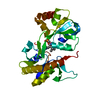
| |||||||||
|---|---|---|---|---|---|---|---|---|---|---|
| 1 | 
| |||||||||
| Unit cell |
| |||||||||
| Components on special symmetry positions |
|
- Components
Components
| #1: Protein | Mass: 29108.453 Da / Num. of mol.: 1 Source method: isolated from a genetically manipulated source Source: (gene. exp.)   |
|---|---|
| #2: Chemical | ChemComp-AT1 / ( |
| #3: Chemical | ChemComp-GOL / |
| #4: Water | ChemComp-HOH / |
-Experimental details
-Experiment
| Experiment | Method:  X-RAY DIFFRACTION / Number of used crystals: 1 X-RAY DIFFRACTION / Number of used crystals: 1 |
|---|
- Sample preparation
Sample preparation
| Crystal | Density Matthews: 3 Å3/Da / Density % sol: 59.05 % |
|---|---|
| Crystal grow | Temperature: 279 K / pH: 6.5 Details: 20% PEG 4000, 0.3 M lithium sulfate, 0.1 M cacodylate, VAPOR DIFFUSION, HANGING DROP, temperature 279K, pH 6.50 |
-Data collection
| Diffraction | Mean temperature: 100 K |
|---|---|
| Diffraction source | Source:  SYNCHROTRON / Site: SYNCHROTRON / Site:  EMBL/DESY, HAMBURG EMBL/DESY, HAMBURG  / Beamline: X11 / Wavelength: 0.812 / Beamline: X11 / Wavelength: 0.812 |
| Detector | Type: MAR CCD 165 mm / Detector: CCD / Date: Jun 13, 2005 |
| Radiation | Protocol: SINGLE WAVELENGTH / Monochromatic (M) / Laue (L): M / Scattering type: x-ray |
| Radiation wavelength | Wavelength: 0.812 Å / Relative weight: 1 |
| Reflection | Resolution: 1.85→25 Å / Num. obs: 29461 / % possible obs: 99.7 % / Observed criterion σ(I): -3 / Redundancy: 4.8 % / Biso Wilson estimate: 21.9 Å2 / Rsym value: 0.059 / Net I/σ(I): 23.1 |
| Reflection shell | Resolution: 1.85→1.92 Å / Mean I/σ(I) obs: 3.8 / Rsym value: 0.357 / % possible all: 99.9 |
-Phasing
| Phasing MR |
|
|---|
- Processing
Processing
| Software |
| ||||||||||||||||||||||||||||||||||||||||||||||||||||||||||||||||||||||||||||||||
|---|---|---|---|---|---|---|---|---|---|---|---|---|---|---|---|---|---|---|---|---|---|---|---|---|---|---|---|---|---|---|---|---|---|---|---|---|---|---|---|---|---|---|---|---|---|---|---|---|---|---|---|---|---|---|---|---|---|---|---|---|---|---|---|---|---|---|---|---|---|---|---|---|---|---|---|---|---|---|---|---|---|
| Refinement | Method to determine structure:  MOLECULAR REPLACEMENT MOLECULAR REPLACEMENTStarting model: PDB ENTRY 1N0T, CHAIN A Resolution: 1.85→24.66 Å / Rfactor Rfree error: 0.006 / Data cutoff high absF: 229797.41 / Data cutoff low absF: 0 / Isotropic thermal model: RESTRAINED / Cross valid method: THROUGHOUT / σ(F): 0 / Stereochemistry target values: ENGH & HUBER Details: THE FULLY REFINED STRUCTURE COMPRISES THR433-GLN492, TRP498-LYS544, THE GLY-THR LINKER, PRO667-SER711 AND SER715-GLY803
| ||||||||||||||||||||||||||||||||||||||||||||||||||||||||||||||||||||||||||||||||
| Solvent computation | Solvent model: FLAT MODEL / Bsol: 48.9 Å2 / ksol: 0.41 e/Å3 | ||||||||||||||||||||||||||||||||||||||||||||||||||||||||||||||||||||||||||||||||
| Displacement parameters | Biso mean: 24.7 Å2
| ||||||||||||||||||||||||||||||||||||||||||||||||||||||||||||||||||||||||||||||||
| Refine analyze |
| ||||||||||||||||||||||||||||||||||||||||||||||||||||||||||||||||||||||||||||||||
| Refinement step | Cycle: LAST / Resolution: 1.85→24.66 Å
| ||||||||||||||||||||||||||||||||||||||||||||||||||||||||||||||||||||||||||||||||
| Refine LS restraints |
| ||||||||||||||||||||||||||||||||||||||||||||||||||||||||||||||||||||||||||||||||
| LS refinement shell | Resolution: 1.85→1.93 Å / Rfactor Rfree error: 0.022 / Total num. of bins used: 8
| ||||||||||||||||||||||||||||||||||||||||||||||||||||||||||||||||||||||||||||||||
| Xplor file |
|
 Movie
Movie Controller
Controller









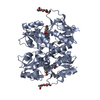
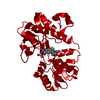
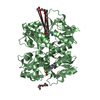
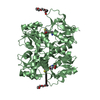

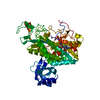
 PDBj
PDBj






